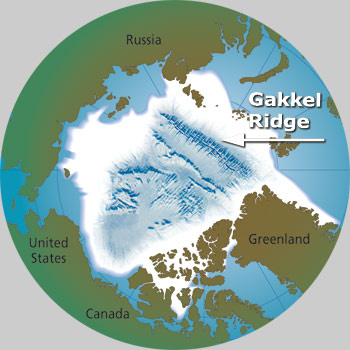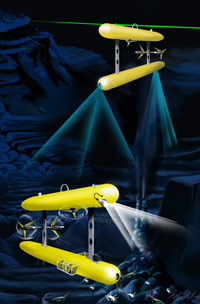Arctic Seafloor Expedition: July 1-Aug. 10, 2007

About the Expedition
No one has ever laid eyes on the bottom of the Arctic Ocean. For the first time in the history of humankind, a scientific team—using unique underwater and under-ice vehicles—will try. Join our expedition this summer on a potentially historic and groundbreaking (and certainly icebreaking) research cruise aboard the Swedish icebreaker Oden.
At the top of the world, the Arctic Ocean is cold, remote, and covered in darkness for half the year. It’s hard enough to get onto the ice-covered ocean. It’s even harder to get under it and down to its seafloor.
For this 40-day cruise to the Gakkel Ridge in the eastern Arctic Ocean, engineers have built two new robotic autonomous underwater vehicles (AUVs). The two vehicles, called PUMA and Jaguar, are designed to be put into holes in the sea ice and to explore the deep reaches of the Arctic Ocean. Many hours later, they will have navigate back to another hole in the ice and be recovered by the icebreaker.
Scientists are excited about what they might find. The Arctic Ocean floor may be different than other oceans—including deep-sea life forms never seen before, or “living fossils” of species that existed when life on Earth was just beginning to evolve. You can follow what happens on this cruise each day through our photojournals—and perhaps witness history unfold.

The Gakkel Ridge
It wasn’t until 2001 that scientists first found tantalizing clues that the Arctic seafloor may be unlike the seafloors of the more-explored Atlantic and Pacific Oceans. They explored the Gakkel Ridge, part of the 60,000-kilometer (40,000-mile) continuous chain of volcanic seafloor mountains that runs like a giant zipper throughout the globe.
The Gakkel Ridge is the northern extension of the Mid-Atlantic Ridge, which runs all the way down the middle of the Atlantic Ocean. At mid-ocean ridges, Earth’s crust spreads apart, allowing hot magma from the mantle to come up and form new ocean crust. The enormous heat sparks chemical reactions between crustal rocks and seawater that seep down into them. These chemical reactions produce hot, mineral-rich fluids that spew like geysers from seafloor vents, as well as massive deposits of minerals, such as copper and zinc. These hydrothermal fluids (from the Greek words for “water” and “heat”) also contain chemicals that sustain rich communities of unusual life forms, which thrive via chemosynthesis, rather than photosynthesis, in the sunless depths.
The Gakkel Ridge is the deepest mid-ocean ridge, ranging from 3 to 5 kilometers (1.8 to 3 miles) deep, and it is also perhaps the slowest-spreading ridge. Consequently, scientists had predicted that there wouldn’t be much volcanic activity on the Gakkel Ridge. They thought the Gakkel Ridge would be more like a crack in the planet where the slowly spreading-apart ridge pulled up solid rock from deep down in Earth’s mantle to form new seafloor.
Much to their surprise, scientists aboard the 2001 cruise dredged up rocks from the Gakkel Ridge that appear to have been chemically transformed by hydrothermal venting. Sensors on their dredging lines also detected whispers of warmer water, chemicals, and particles that are present in plumes of vent fluids that billow out from small vents.
Science objectives
The goal of the Gakkel Ridge expedition is to see if active hydrothermal vents are really there, to find them, and to learn if they, and the communities of life around them, are different.
Since hydrothermal vents were first discovered in 1977, scientists have learned that on the seafloor, as on land, distinct animal populations have evolved in different regions. Will Arctic vents have shrimp, as Atlantic vents do, or clams, as Pacific vents do? Or will it have completely new species?
There is reason to think that it might. We think the Arctic Ocean became enclosed about 65 million years ago and since then has not had deep-water connections with neighboring oceans. So, animals in the Arctic may have evolved in isolation—much the way animals in Australia did—producing different kinds of species such as kangaroos and koalas, which are found nowhere else.
Because Gakkel Ridge rocks have a fundamentally different chemical composition, the chemical reactions between the rocks and seawater are also different. This could produce unusual vent chemicals that can support unusual forms of life. Because Gakkel Ridge rocks also resemble the kind of rocks that erupted billions of years ago, life on Arctic vents may also resemble early life on our planet.
Join our team as we send AUVs to the bottom of the ice-covered Arctic Ocean for the first time. Whatever happens and whatever we find is guaranteed to be unprecedented.


